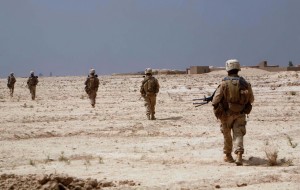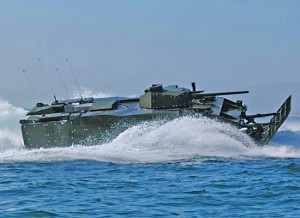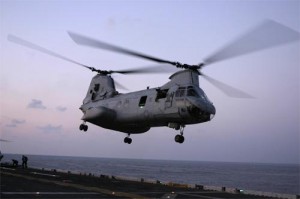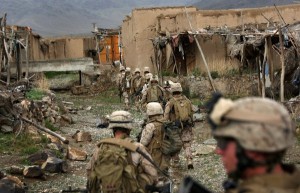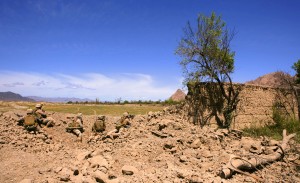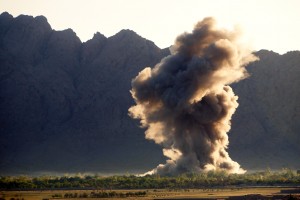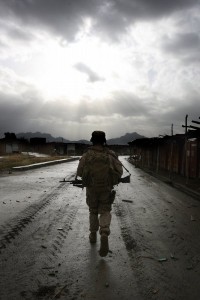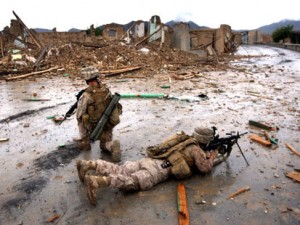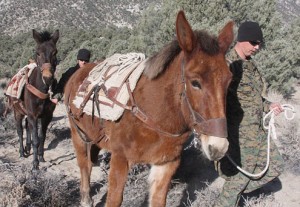I want to touch on several issues in this post. First, Galrahn at Information Dissemination authors yet another interesting post on Navy strategy, or the lack of it. It should be required reading for all of my readers. His discussion of Navy strategy and issues surrounding the Navy is second to none. He says that the Navy has proven that they are unable tactically to solve piracy. But while I agree with his dismissal of the Littoral Combat Ship as being the answer, I don’t agree with this assessment.
I have said before that the things required of us to defeat the pirates are less attractive to 21st century America that the alternative of having pirates, and thus we have chosen for piracy to exist. The tools exist: Amphibious Assault Docks, LCACs, Harriers, Helicopters associated with ESG, etc. And just to make it clear, if we really wanted to be effective, we could deploy the newer generation of Riverine Command Boats along with the Amphibious Assault Docks, or some smaller water craft (with assault capability). Hanging pirates on the high seas, videotaping the events and posting it to YouTube would end piracy, and it is given to the Congress of the U.S. in the Constitution to make such laws. Finally, such laws would supersede all ambiguous treaties in this matter. In followup to previous posts on piracy, Navy SEAL teams are not an answer. There aren’t enough, it is too expensive, and it isn’t logistically sustainable.
Donald Sensing makes the point in the comments section that piracy isn’t a national security issue for the U.S. Perhaps so, right now, but as the pirates continue to give honorariums to al Qaeda which is currently in control of most of Somalia, it might be in the near future. As the problem continues it grows worse.
On to the part about Naval strategy. I tend to believe that if the strategic thinking is there, the Navy is not doing a very good job of communicating it. Now comes a strange twist from the Navy about the future of its participation in the ESG.
The Navy is breaking up the deployments of amphibious ships and surface combatants formerly known as expeditionary strike groups, part of a top-down review that could have far-reaching consequences for how sailors and Marines spend time at sea.
For the past six years, ESGs paired a big-deck amphib and two small-deck gators with two or three surface combatant escorts. Now, the gators and warships will go separately.
As of March 9, the gator groups were renamed “amphibious ready groups,” reviving a term that was shelved several years ago, and combined with the name of their accompanying Marine expeditionary unit, said Lt. Cmdr. Phil Rosi, a spokesman for Fleet Forces Command. Although these were the first changes to come from a joint Navy-Marine ESG working group, they won’t be the last, he said.
“The name change and the deployment construct is the first step in the process — we have, in conjunction with the Marine Corps and [the] ESG working group, been working through roles, missions, capability, training … there’s a lot more that still is being worked out.”
For example, the Navy would have called the amphibious assault ship Boxer’s group the “Boxer ESG,” but now it’s called the “Boxer ARG/13th MEU.”
But ESG isn’t going away entirely. An ARG/MEU still can be called an ESG, Rosi said, if it’s being commanded by an admiral or general officer.
Under normal circumstances, a Navy captain will command the ships and a Marine colonel will be in charge of the leathernecks.
Rosi said Fleet Forces Command and the ESG working group still are determining who will decide when an ARG/MEU’s mission requires a one-star officer and elevates the unit to ESG status.
The Navy decided to break up the previous ESGs because the amphibs and combatants usually didn’t work closely enough on their deployments to justify sailing together, Rosi said.
So surface combatants will begin sailing separately as “surface action groups” — another older term — although officials don’t yet know how that could affect their deployments. He also said it wasn’t clear yet whether the surface groups would include set numbers of ships — a certain number of cruisers, destroyers or frigates — or how their missions could change.
“There’s no definite cookie-cutter construct,” Rosi said.
Rosi said ARG/MEUs and surface groups will retain their ability to operate together when needed, but they won’t sail in groups as they have since 2003.
Retired Capt. Jan van Tol said it’s “unfortunate” that the Navy is returning to an older style of surface deployments, but he said he wasn’t surprised because top commanders never fully realized a strategy to deploy amphibs with warships.
“It’s completely back to the future. I guess ESGs weren’t as useful as we thought,” said van Tol, who commanded three ships, including the amphibious assault ship Essex, before becoming an analyst for the Center for Strategic and Budgetary Assessments.
ESGs were ideal groups for handling low-intensity missions such as the international campaign against piracy off Somalia, he said, because they combine the speed and firepower of surface ships with many “lily pads” for helicopters on the gators. The amphibious assault ship Boxer, for example, is operating with the destroyer Bainbridge and frigate Halyburton off the Horn of Africa.
What’s more, ESGs were a way to overcome the “artificial divorce” in the surface force between amphib and “cru/des” sailors, van Tol said. He recalled a time when he was the captain of the Essex and his ship participated in a missile-launching exercise with the destroyer John S. McCain, giving the ships’ crews a chance to work together.
Then-Chief of Naval Operations Adm. Vern Clark pushed for ARGs to become ESGs in the early 2000s, based on an earlier concept from the 1990s called an Expeditionary Task Force.
But with Clark retired, few top-level Navy and Marine Corps leaders stayed committed to pairing amphibs and combatants.
“It’s dying due to lack of interest, which is a pity,” van Tol said.
Several fairly brief observations. I will reserve comment for now on the extreme expense of deploying an entire Battalion of Marine infantry on board an Amphibious Assault Dock and floating around the Persian Gulf for seven months as “ready reserve” for CENTCOM or “force in readiness.” It deserves fuller analysis, much more than I can provide here. The public has absolutely no idea how expensive this endeavor is.
But this account above is about as strange as it gets. We’re bored, says the Navy, or something thereabouts. We learn nothing useful about any paradigmatic change in strategy that caused this divorce, or some new boundary condition or external pressure that is causing the need to separate larger warships from ESGs. It’s about personalities, or some such foolishness. Maybe. We don’t know. We just learn that it’s going to happen.
Finally, as I stated in Concerning U.S. Defense Cuts, “The Captain’s Journal agrees with Galrahn and the importance of force projection – whether hard or soft power – with the Marines Expeditionary Units (including the “combined arms” concept of multiple naval vessels with various defensive and offensive capabilities … Concerning Galrahn’s warning on the need for fuel, this highlights all the more the need for ports and air superiority for refueling tankers. Concerning overall air superiority, if the sole focus of our national defense dollars is in counterinsurgency, littoral combat and small wars, the MEUs will be left to the slaughter once the ordnance begins raining down from the sky.”
I am continually re-evaluating the need for MEUs, especially when there is such dire need for Marine infantry in Afghanistan. I am only softly committed to MEUs. Someone can try to convince me, but it may be a tall task. But if we are going to do MEUs and ESGs, we had better consider the danger and risk of deploying Amphibious Assault Docks (AAD) without the accompanying Naval force protection.
I normally assume that the detection and defeater systems for surface-to-surface missiles on board the Navy vessels would add to the force protection for the AADs. I also assume that an Aircraft Carrier fleet is not too distant from the AADs to provide air superiority in the case of air attack. I am also assuming that the Navy wouldn’t hesitate to use its power to protect the Marines.
Your assignment: Think hard. An entire Battalion of Marine infantry sitting on an Amphibious Assault Dock in the middle of the Persian Gulf like sitting ducks, with little Naval force protection, and the likely to come reduction in the Carrier battle groups by at least one. The Navy won’t deploy with the Marines. Can you justify this? Seriously? Wouldn’t it be better to deploy the Navy or find another way to use the Marines? Why have the ESG to begin with? What is the Navy thinking? We don’t know – it seems as if they’re bored. Oh wait! As I re-read the above, there is an “ESG working group.” Good. I feel better already.
